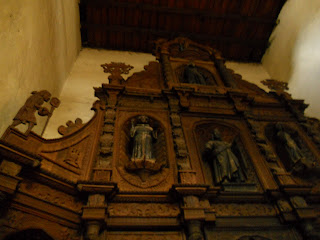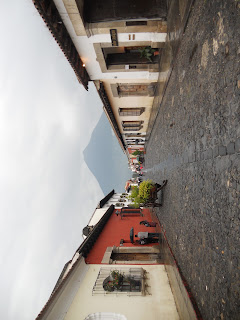Hello again,
Well here I am at the end of day 2 of Spanish school and I am completely exhausted. I had another great but long day. To give you an idea of the kinds of stories I am being told, here's how I began my day. The first thing we did today was my instructor told me amazing stories about his village, San Antonio Agua Caliente and how it is connected to another village over 200km away via any underground natural tunnel. He told many stories about this tunnel including one about how years ago a local Maya group asked the government of the town to come to the tunnel for a ceremony. Apparently, the government granted permission but had a couple of their own people accompany the group into the tunnel. With large torches, the group entered the tunnel approximately 45km before reaching a larger clearing/opening (still in the tunnel but a large circular part of it) where the Maya group conducted a ceremony that lasted 3-4 hours.
The ceremony was apparently to give thanks to a specific deity for the good fortune that this group had recently experiences. Here Caesar pointed out that if the group did not offer thanks it was likely very poor luck would befall them. In any event, during the ceremony they gave many offerings of food and drink (rum included) to the supernatural deity associated with that particular place. (later they drank and ate in the tunnel a large amount of food and alcohol as part of the ceremony). A very long, well told, story short, before leaving, the group left offering of precious stones (gold, silver, jade, etc.). But the local people who accompanied the group decided to return and rob those items the next day. When the would-be-robbers came to the cavern they did not find the stones anywhere but instead the clearing in the tunnel was filled with snakes. He spoke about how those offerings were not for individuals but for the supernatural and how it was so important for the group to give thanks and an offering to the supernatural to keep things in balance! It was quite a tale!
From here we moved onto discussions ranging from futbol (soccer) to the impact of the arrival of the Spanish in the New World, to current political elections, to archaeological ethics! It is very interesting to have to express my ideas on very complex subjects using my more limited vocabulary. It forces me to think through what I'm actually try to say in a very different way and I find that I think more deeply about my ideas on a subject because of having to work hard to express complex ideas in my non-native language. It is fun, though exhausting, for my brain to think in Spanish and in English. I find myself thinking in Spanish when I'm needing to express myself or listening to someone else speaking in Spanish (in other words using it immediately) but the rest of the time my thoughts are mostly in English though sometimes in Spanish. I wonder the rate at which this change occurs. Even writing this last sentence in my mind I said "I wonder the rate at which este cambio occurs". This is happening readily, where I will think a mostly Spanish phrase with an English word thrown in there or vis versa. It is completely unintentional and continues to happen over and over again as I write this to you. In this past sentence I just had to translate my thought out of Spanish and into English.
In any event, I apologize if my writing becomes less clear as I become more and more fatigued but want to discuss one subject that has come up time and again both in my previous experiences in Central America and on this trip. This subject has to do with my personal positionality. In short all of us have our own positionality and as anthropologists it influences how we perceive and are perceived by others. We all belong to a variety of groups, have variable experiences, and have our individuals worldview. To spare the lecture on positionality, think of the all the ways that a particular researcher might be treated differently or might see their subject matter differently simply because of certain aspects of themselves (e.g. their gender). As one gender you might have greater access to certain types of subject matter and not others. Okay, so when it comes to my positionality, as you by now have read I have a wife. When I say in English that I have a wife while it might catch some people off-guard if they assumed I was straight (or didn't think I look like a lesbian), it is still very clear that I mean that I (a woman) am married to another woman. This is not at all the case in Spanish both because it is my second language and because of the construction of the language.
In Spanish, a common word for wife is esposA and a common word for husband is esposO (I capitalized the letters so you see this is a difference of one letter- the feminine vs. masculine forms of the word). Okay so each time I talk about my wife (side note- who by the way is at the airport right now and coming to visit me tomorrow for my birthday) (mi esposa) everyone assumes that I making a very basic Spanish mistake and not recognizing the difference between feminine and masculine forms. What is very interesting about this is that these are people with whom in many cases I have already spoken with for some time and have successfully demonstrated my knowledge of the difference between masculine and feminine words. Without fail, every person stops to correct this and giggles as they gingerly explain (as if to a child) how I'm not married to a woman but rather to a man. Now, this is not at all their fault but rather illustrates their world view and the strong heteronormativity (think assumptions of straightness) of the culture. It takes some convincing, usually me saying something like "actually yes, I'm married to a woman and her name is Lauren" before they will accept this is not just an error in the feminine/masculine forms of the word.
I've tested this often by saying "My esposa..." and not following it immediately with statements about her being a woman and her name. Every single time people are convinced I am making an error and when they finally realize I'm not often say something to the effect of "No, really?" Of course I'm very used to coming out regularly in both English and Spanish but it is more difficult to come out in Spanish because of the construction of the language. Thus I find Spanish takes a little more effort than simply being about to use the term "wife" and have it understood. That said, I have never had any truly negative experiences. While it might bother some due to religious or personal beliefs, the majority of people are seemingly curious but still kind once they realize I have a wife.
Okay my brain power is rapidly decreasing. Enjoy your 4th of July- it is after all my favorite day of the year (my birthday) !




























 The central altar at Santiago Atitlan's Catholic Church was a deliberate attempt to recognize the integration of these religious and cultural traditions. In 1976 the altar was begun to be renovated by Diego Chavez Petzey and Nicolas Chaves Sojuel unde rthe direciton of Father Francisco Rother. The altar incorporates both traditional Catholic and Maya symbolism that was meant to show the unity of these traditions in the lives of the people of the church. According to some at the church, the priest that succeeded Father Rother had tried to remove the Maya influence from the church but the community would not allow it. Please enjoy the photos of this amazing blend of religious and cultural symbolism.
The central altar at Santiago Atitlan's Catholic Church was a deliberate attempt to recognize the integration of these religious and cultural traditions. In 1976 the altar was begun to be renovated by Diego Chavez Petzey and Nicolas Chaves Sojuel unde rthe direciton of Father Francisco Rother. The altar incorporates both traditional Catholic and Maya symbolism that was meant to show the unity of these traditions in the lives of the people of the church. According to some at the church, the priest that succeeded Father Rother had tried to remove the Maya influence from the church but the community would not allow it. Please enjoy the photos of this amazing blend of religious and cultural symbolism.
























